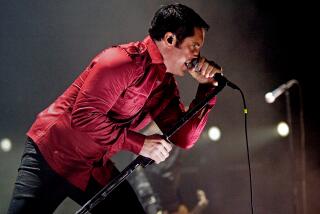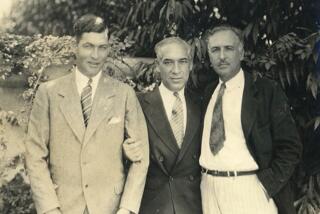‘Fools Crow’ by James Welch (Viking: $18.95; 316 pp.)
When James Welch published his first novel, “Winter in the Blood,” in 1974, he joined N. Scott Momaday as only the second American Indian novelist at that time to have produced a truly outstanding work of fiction. Since the appearances of Momaday’s “House Made of Dawn” (1960) and Welch’s “Winter in the Blood,” however, a significant escalation has taken place in the publication of important novels by American Indian writers, with Leslie Silko’s “Ceremony” coming out in 1977 followed by Welch’s second novel, “The Death of Jim Loney,” and other impressive novels by such Indian writers as Janet Campbell Hale, Paula Gunn Allen, Gerald Vizenor and Louise Erdrich. Although novels by American Indian writers have been appearing in a steady, though slim, stream since Simon Pokagon’s “Queen of the Woods” in 1899, only since 1969 has the Indian novel begun to come of age. Welch’s third novel, “Fools Crow,” marks an important step in that movement toward a maturation of both style and vision.
Welch is a Blackfoot-Gros Ventre Indian, a graduate of the University of Montana. Drawing upon his Blackfoot heritage, and, more critically, upon his own sense of what it means to be “Indian” in late 20th-Century America, in “Fools Crow,” Welch has written an extraordinary novel.
“Fools Crow” is set in the final crisis years of the American Indian High Plains culture--around 1870, when the buffalo herds are falling before the marvelous efficiency of repeating rifles and the Indians are being decimated by the less-efficient but still deadly assault of smallpox and the U.S. military. Although the narrative point of view shifts at times to create a finely layered complexity, the novel focuses primarily upon the consciousness of a member of an isolated band of Blackfeet, a young man called White Man’s Dog, who, in the course of the novel, grows into the hunter, warrior and healer named Fools Crow. Fools Crow’s coming of age parallels the final brief period of traditional life for the Blackfeet, once the most powerful tribe on their part of the continent. As the power of Fools Crow grows, that of his people declines. It becomes the responsibility of Fools Crow to foresee and bear witness to the extermination of the traditional way of life for his people.
Welch’s first published volume, a collection of poems entitled “Riding the Earthboy 40” (1971), introduced the reservation world of the contemporary Montana Indian as seen through the flint-sharp eyes of a tricksterish surrealism.
Both of Welch’s first two novels were experiments, impressively successful attempts to merge American Indian history and mythology with absurdism, surrealism, and black humor in a torturous quest for the protagonists’ identity as Indians in contemporary America. In interesting ways, however, “Fools Crow” is a more dangerous book for Welch than these first two and, perhaps, his most radical experiment yet. In this work, Welch has taken the risk of writing in high seriousness, abandoning the black humor, absurdism and structural high jinks of his earlier fiction. The result is a novel that plunges the reader with startling abruptness wholly into an Indian world, a world in which reality is idyllic and bitter, hard-edged and magical.
In this novel, Welch is re-membering the world of his ancestors, putting that world together again in a way that will tell both author and reader what has been lost and what saved. In the Indian world of this novel, Raven flutters down to give advice in his wise-old-man, tough-guy trickster voice, and Welch offers no apology or explanation for this bit of magic--this is simply the way it is, or was. Similarly, when Fools Crow, in a dream-vision, is summoned three days’ ride northward to meet with a figure from Blackfoot mythology and to be shown a stark outline of his people’s future, the reader must accept the spiritual encounter on Indian terms. Welch’s Blackfeet in “Fools Crow,” like many Indian people today, live in a world that acknowledges no separation between man and the natural or supernatural worlds.
“Fools Crow” is a painful, stunning act of recovery, the completion of an identity quest that began for Welch in his first poems and novels. In this novel, Welch takes a major gamble, for at times, the carefully articulated speech of the author’s Blackfeet is inevitably reminiscent of the stilted Oxfordian verbiage found in romantic treatments of Indians from James Fenimore Cooper to the Hollywood Western. Rescuing this novel from such guilt by association, however, is a hardness and precision of language lacking in nearly every other fictional attempt to render Indian speech in English, an absolute certainty of voice. More important, perhaps, is the fact that no appropriation of Indian culture is going on here; the author writes from within this imagined world rather than from without. In “Fools Crow,” the non-Indian is the outsider who must recognize a new world and adapt.
The fundamentally mimetic realism of “Fools Crow” may well meet with its detractors. Even more surely, it will provide critics with another opportunity to write nostalgically about what American Indian culture was like. What Welch has accomplished, however, has been to remind us, as well as himself, of what is still there. Perhaps the most profound implication of this novel is that the culture, the world-view brought so completely to life in “Fools Crow,” is alive and accessible in the self-imagining of contemporary Blackfeet and other American Indians. In recovering the world found in this novel, Welch serves as storyteller, bearer of oral tradition and definer of what it means to be Indian today.
More to Read
Sign up for our Book Club newsletter
Get the latest news, events and more from the Los Angeles Times Book Club, and help us get L.A. reading and talking.
You may occasionally receive promotional content from the Los Angeles Times.






